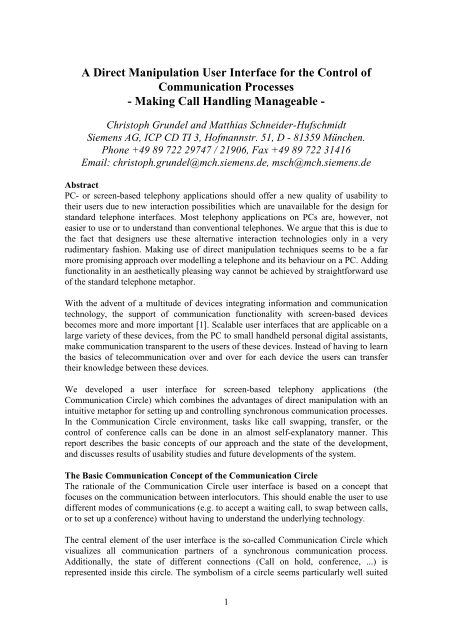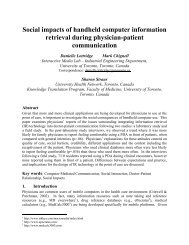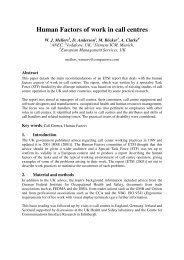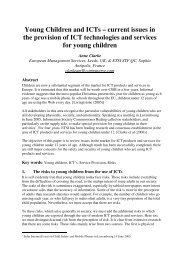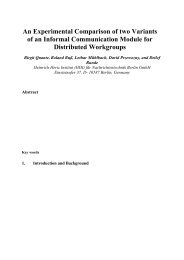A Direct Manipulation User Interface for the Control of ...
A Direct Manipulation User Interface for the Control of ...
A Direct Manipulation User Interface for the Control of ...
Create successful ePaper yourself
Turn your PDF publications into a flip-book with our unique Google optimized e-Paper software.
A <strong>Direct</strong> <strong>Manipulation</strong> <strong>User</strong> <strong>Interface</strong> <strong>for</strong> <strong>the</strong> <strong>Control</strong> <strong>of</strong><br />
Communication Processes<br />
- Making Call Handling Manageable -<br />
Christoph Grundel and Matthias Schneider-Hufschmidt<br />
Siemens AG, ICP CD TI 3, H<strong>of</strong>mannstr. 51, D - 81359 München.<br />
Phone +49 89 722 29747 / 21906, Fax +49 89 722 31416<br />
Email: christoph.grundel@mch.siemens.de, msch@mch.siemens.de<br />
Abstract<br />
PC- or screen-based telephony applications should <strong>of</strong>fer a new quality <strong>of</strong> usability to<br />
<strong>the</strong>ir users due to new interaction possibilities which are unavailable <strong>for</strong> <strong>the</strong> design <strong>for</strong><br />
standard telephone interfaces. Most telephony applications on PCs are, however, not<br />
easier to use or to understand than conventional telephones. We argue that this is due to<br />
<strong>the</strong> fact that designers use <strong>the</strong>se alternative interaction technologies only in a very<br />
rudimentary fashion. Making use <strong>of</strong> direct manipulation techniques seems to be a far<br />
more promising approach over modelling a telephone and its behaviour on a PC. Adding<br />
functionality in an aes<strong>the</strong>tically pleasing way cannot be achieved by straight<strong>for</strong>ward use<br />
<strong>of</strong> <strong>the</strong> standard telephone metaphor.<br />
With <strong>the</strong> advent <strong>of</strong> a multitude <strong>of</strong> devices integrating in<strong>for</strong>mation and communication<br />
technology, <strong>the</strong> support <strong>of</strong> communication functionality with screen-based devices<br />
becomes more and more important [1]. Scalable user interfaces that are applicable on a<br />
large variety <strong>of</strong> <strong>the</strong>se devices, from <strong>the</strong> PC to small handheld personal digital assistants,<br />
make communication transparent to <strong>the</strong> users <strong>of</strong> <strong>the</strong>se devices. Instead <strong>of</strong> having to learn<br />
<strong>the</strong> basics <strong>of</strong> telecommunication over and over <strong>for</strong> each device <strong>the</strong> users can transfer<br />
<strong>the</strong>ir knowledge between <strong>the</strong>se devices.<br />
We developed a user interface <strong>for</strong> screen-based telephony applications (<strong>the</strong><br />
Communication Circle) which combines <strong>the</strong> advantages <strong>of</strong> direct manipulation with an<br />
intuitive metaphor <strong>for</strong> setting up and controlling synchronous communication processes.<br />
In <strong>the</strong> Communication Circle environment, tasks like call swapping, transfer, or <strong>the</strong><br />
control <strong>of</strong> conference calls can be done in an almost self-explanatory manner. This<br />
report describes <strong>the</strong> basic concepts <strong>of</strong> our approach and <strong>the</strong> state <strong>of</strong> <strong>the</strong> development,<br />
and discusses results <strong>of</strong> usability studies and future developments <strong>of</strong> <strong>the</strong> system.<br />
The Basic Communication Concept <strong>of</strong> <strong>the</strong> Communication Circle<br />
The rationale <strong>of</strong> <strong>the</strong> Communication Circle user interface is based on a concept that<br />
focuses on <strong>the</strong> communication between interlocutors. This should enable <strong>the</strong> user to use<br />
different modes <strong>of</strong> communications (e.g. to accept a waiting call, to swap between calls,<br />
or to set up a conference) without having to understand <strong>the</strong> underlying technology.<br />
The central element <strong>of</strong> <strong>the</strong> user interface is <strong>the</strong> so-called Communication Circle which<br />
visualizes all communication partners <strong>of</strong> a synchronous communication process.<br />
Additionally, <strong>the</strong> state <strong>of</strong> different connections (Call on hold, conference, ...) is<br />
represented inside this circle. The symbolism <strong>of</strong> a circle seems particularly well suited<br />
1
<strong>for</strong> this purpose given that it can be expected to be understood by people from different<br />
cultures as well as by children.<br />
The user <strong>of</strong> <strong>the</strong> system is represented by an icon/picture in <strong>the</strong> centre <strong>of</strong> <strong>the</strong> circle. This<br />
icon may be replaced upon identification <strong>of</strong> <strong>the</strong> user if more than one person uses <strong>the</strong><br />
system. To call a partner, <strong>the</strong> user drags an icon representing this partner into <strong>the</strong> circle.<br />
Selection <strong>of</strong> communication partners is done from a structured directory by dragging<br />
ei<strong>the</strong>r icons or phone-numbers. Access to redial lists and missed-calls lists is done in a<br />
similar way.<br />
If <strong>the</strong> partner can be reached by different means (Mobile, video, analogue phone<br />
network, or ISDN), <strong>the</strong> user can prioritise <strong>the</strong>se means, choose a default connection <strong>for</strong><br />
each partner or explicitly choose one <strong>of</strong> <strong>the</strong>se possibilities. Incoming calls are indicated<br />
by an icon / number appearing on <strong>the</strong> outline <strong>of</strong> <strong>the</strong> circle. The call can <strong>the</strong>n be accepted<br />
by dragging <strong>the</strong> icon / number into <strong>the</strong> circle.<br />
In a conference situation, all interlocutors are visible inside <strong>the</strong> circle, each one<br />
positioned on a dedicated segment <strong>of</strong> <strong>the</strong> circle. Members <strong>of</strong> <strong>the</strong> conference using <strong>the</strong><br />
same user interface on <strong>the</strong>ir device see <strong>the</strong> same group in <strong>the</strong> circle on <strong>the</strong>ir PC with <strong>the</strong><br />
convenor <strong>of</strong> <strong>the</strong> conference clearly marked. It is worth noting that <strong>the</strong> system works with<br />
remote parties using <strong>the</strong> same interface as well as with parties using standard telephone<br />
equipment.<br />
In a communication situation with active partners and partners on hold, <strong>the</strong> different<br />
segments are distinguished by different background colours. It is <strong>the</strong>re<strong>for</strong>e very easy to<br />
interpret <strong>the</strong> state <strong>of</strong> <strong>the</strong> communication with each partner. Clicking on <strong>the</strong> icon <strong>of</strong> a<br />
partner toggles <strong>the</strong> state <strong>of</strong> <strong>the</strong> communication with this partner. Dragging partner icons<br />
from one segment to ano<strong>the</strong>r allows <strong>for</strong> conference set-up with multiple users.<br />
2
Fig. 1:<br />
The basic design <strong>of</strong> <strong>the</strong> Communication Circle user interface in a situation with<br />
one call on hold and a consultation call with a second communication partner.<br />
Switching between different states (incoming call, outgoing call, call waiting, call on<br />
hold, active) is visualised through animation to make it easier <strong>for</strong> <strong>the</strong> user to understand<br />
how a communication situation changes.<br />
The Interaction Concept <strong>of</strong> Communication Circle<br />
The basic interaction concept is based on moving communication partners into or out <strong>of</strong><br />
<strong>the</strong> communication circle by direct manipulation. Moving <strong>the</strong> icon <strong>of</strong> a partner into <strong>the</strong><br />
circle initiates a call set-up, incoming calls are visualised on <strong>the</strong> line <strong>of</strong> <strong>the</strong> circle.<br />
Moving <strong>the</strong> icon into <strong>the</strong> circle means call acceptance, moving it to <strong>the</strong> outside results in<br />
call rejection. Moving <strong>the</strong> icon to <strong>the</strong> answering device icon results in <strong>the</strong> expected<br />
activity. All <strong>the</strong>se activities can be done by simple drag&drop actions.<br />
3
Status<br />
5 1<br />
Call in progress with Huber<br />
2<br />
3<br />
Consultation<br />
Müller<br />
Conference<br />
4<br />
Transfer<br />
Terminate<br />
Huber<br />
Huber<br />
6<br />
Functions available<br />
Communication partners (direct station selection keys)<br />
Telephone<br />
Display or Touchscreen<br />
S<strong>of</strong>tkeys instead <strong>of</strong> Touchscreen<br />
Fig. 2: Schematic representation showing <strong>the</strong> ”interaction concept”:<br />
1. Initiate consultation by pressing a key (s<strong>of</strong>tkey); <strong>the</strong>n entry <strong>of</strong> destination<br />
2. Initiate consultation by touching or clicking with <strong>the</strong> mouse, <strong>the</strong>n entry <strong>of</strong><br />
destination<br />
3. <strong>Direct</strong> party selection by touching or clicking with <strong>the</strong> mouse (implicit holding <strong>of</strong><br />
first partner)<br />
4. <strong>Direct</strong> party selection by drag and drop (implicit holding <strong>of</strong> first partner)<br />
5. <strong>Direct</strong> party selection by pressing a key (s<strong>of</strong>tkey; implicit holding <strong>of</strong> first partner)<br />
Toggling between parties is carried out by clicking on partners or <strong>the</strong>ir circle segments<br />
(”see and show” principle: ”I want to talk to that person”). Clicking on empty areas in<br />
<strong>the</strong> circle results in seizure <strong>of</strong> a free line - in an active call situation this action can be<br />
used to initiate consultation.<br />
The outstanding advantage <strong>of</strong> direct manipulation in a telephony application is that <strong>the</strong><br />
relevant function is initiated by <strong>the</strong> user action without <strong>the</strong> user having to explicitly<br />
select it or even know <strong>the</strong> function’s precise designation.<br />
Alongside this <strong>the</strong>re is <strong>the</strong> possibility - intended especially <strong>for</strong> users with knowledge <strong>of</strong><br />
classical enhanced-convenience telephony - <strong>of</strong> controlling communication connections<br />
using conventional function keys whose labelling (plain text and/or symbol) tells users<br />
something about <strong>the</strong> type <strong>of</strong> function. This approach is supplemented by a special<br />
preview function. When <strong>the</strong> preview function is activated, <strong>the</strong> selection <strong>of</strong> a function<br />
key will display an image in a small circle below <strong>the</strong> communication circle symbolically<br />
showing <strong>the</strong> effect <strong>of</strong> <strong>the</strong> selected function. The user now has <strong>the</strong> opportunity to carry<br />
out this function or to select ano<strong>the</strong>r function key if <strong>the</strong> preview does not show <strong>the</strong><br />
image she expected.<br />
The interaction concept shown in Fig. 2 is not limited to corded communication.<br />
Provision is also made <strong>for</strong> interactions from a mobile phone or cordless handset/headset<br />
4
using a navigator. The widest variety <strong>of</strong> manipulation techniques can be used on <strong>the</strong><br />
display depending on <strong>the</strong> level <strong>of</strong> equipping:<br />
• TAB mode (strictly linear chaining <strong>of</strong> selectable elements, <strong>for</strong>ward/backward<br />
navigation)<br />
• Zap mode (horizontal/vertical branches to nearest selectable elements)<br />
• Mouse mode (free positioning <strong>of</strong> entry/selection mark).<br />
Usage Scenario<br />
The following scenario describes a standard telephony application with <strong>the</strong> following<br />
flow <strong>of</strong> operations:<br />
• <strong>Direct</strong> station selection with ”direct station selection key” to <strong>the</strong> 2-party call<br />
• 2-party call<br />
• <strong>Direct</strong> station selection to <strong>the</strong> second call (consultation)<br />
• Second call<br />
• Conference preview<br />
• Conference<br />
The scenario focuses on <strong>the</strong> use <strong>of</strong> buttons in order to elucidate <strong>the</strong> simplicity <strong>of</strong> <strong>the</strong> UI<br />
in combination with <strong>the</strong> preview function.<br />
Starting point: idle condition<br />
The telephony application is opened and is in <strong>the</strong> idle condition. The user has activated<br />
<strong>the</strong> preview function in ”Settings”. The preview circle is indicated but is empty because<br />
no function has been selected.<br />
In this example <strong>the</strong> address field (left-hand side <strong>of</strong> <strong>the</strong> display field) is predominantly<br />
occupied by direct station selection keys. One <strong>of</strong> <strong>the</strong> keys signals that <strong>the</strong> party is<br />
currently busy. All o<strong>the</strong>r parties are currently free. The idle condition, represented by <strong>the</strong><br />
time <strong>of</strong> day/date and terminal ”owner’s” directory number, is displayed in <strong>the</strong> status and<br />
entry bar above <strong>the</strong> communication circle. The communication circle also signals <strong>the</strong><br />
idle condition.<br />
If <strong>the</strong> user presses <strong>the</strong> direct station selection ”O. Müller” <strong>the</strong> system initiates a call to<br />
<strong>the</strong> respective party. After Müller accepts <strong>the</strong> call, <strong>the</strong> system represents <strong>the</strong> call<br />
condition by changing <strong>the</strong> colour <strong>of</strong> <strong>the</strong> respective segment <strong>of</strong> <strong>the</strong> circle (Fig. 4).<br />
5
Fig. 3: Telephony application in ”idle condition”<br />
Fig 4: System representation with one active call.<br />
To establish a consultation call to a second part, “Heller”, <strong>the</strong> user only has to select <strong>the</strong><br />
direct station key labelled with <strong>the</strong> respective name. The same effect could be achieved<br />
by dragging <strong>the</strong> labelled area “Heller” into <strong>the</strong> “Idle” section <strong>of</strong> <strong>the</strong> circle. The system<br />
puts <strong>the</strong> active first call on hold and initiates a second call to “Heller”. After this call is<br />
accepted <strong>the</strong> display looks as in Fig. 5.<br />
In this situation <strong>the</strong> user may initiate a conference call. To achieve this she simply has to<br />
press <strong>the</strong> button labelled “Konferenz einleiten (Initiate conference)”. If she is not sure<br />
about <strong>the</strong> outcome <strong>of</strong> this interaction she may click on this button once to get a preview<br />
<strong>of</strong> <strong>the</strong> respective outcome. Fig. 6 shows <strong>the</strong> system response to a preview request<br />
submitted by <strong>the</strong> user. A little circle on <strong>the</strong> bottom <strong>of</strong> <strong>the</strong> window shows what <strong>the</strong> result<br />
<strong>of</strong> selecting this button will be. If she is satisfied <strong>the</strong> action can be executed by pressing<br />
<strong>the</strong> button a second time. An alternative to choosing <strong>the</strong> “Konferenz einleiten (Initiate<br />
conference)” button would be to drag <strong>the</strong> inactive party into <strong>the</strong> active segment <strong>of</strong> <strong>the</strong><br />
circle. Fig. 7 shows <strong>the</strong> display after <strong>the</strong> conference is initiated by <strong>the</strong> user. After this<br />
user action <strong>the</strong> set <strong>of</strong> available command has changed. This is visible by <strong>the</strong><br />
modification <strong>of</strong> <strong>the</strong> button row in <strong>the</strong> upper right corner <strong>of</strong> <strong>the</strong> window.<br />
Fig. 5: Consultation call; <strong>the</strong> first call is on hold.<br />
6
Fig 6: Preview window showing a conference situation<br />
Fig. 7: Conference call situation after <strong>the</strong> user pressed <strong>the</strong> “Konferenz einleiten (Initiate<br />
conference)” button a second time.<br />
The conference can be ended by replacing <strong>the</strong> handset or directly moving <strong>the</strong><br />
conversation partners out <strong>of</strong> <strong>the</strong> Communication Circle. The display will <strong>the</strong>n return to<br />
idle condition (Fig. 3).<br />
<strong>User</strong> Testing<br />
The prototype <strong>of</strong> <strong>the</strong> communication circle UI was evaluated by 20 users in a usability<br />
test. Although <strong>the</strong> functionality <strong>of</strong> this prototype is far from being complete, <strong>the</strong> results<br />
<strong>of</strong> <strong>the</strong> usability test are very satisfactory. In particular, <strong>the</strong> subjective evaluation <strong>of</strong> <strong>the</strong><br />
interface was extremely positive. The concept seems to be fairly easy to understand and<br />
users had no problems to control <strong>the</strong>ir communication processes after a short<br />
introduction by <strong>the</strong> evaluator. The screenshots shown in this article already show <strong>the</strong><br />
improved version <strong>of</strong> <strong>the</strong> Communication Circle UI<br />
Discussion<br />
We have implemented a prototype <strong>of</strong> <strong>the</strong> Communication Circle user interface <strong>for</strong> a<br />
system <strong>for</strong> Internet telephony. In this prototype we use <strong>the</strong> concept <strong>of</strong> <strong>the</strong><br />
communication circle also <strong>for</strong> co-operative work (application sharing) and <strong>for</strong><br />
asynchronous communication processes (email, file transfer, fax transfer).<br />
7
An important topic <strong>for</strong> <strong>the</strong> future development <strong>of</strong> <strong>the</strong> communication circle concept is<br />
<strong>the</strong> question <strong>of</strong> scalability <strong>of</strong> <strong>the</strong> interface. It is our goal to <strong>of</strong>fer <strong>the</strong> same UI on a wide<br />
range <strong>of</strong> different communications devices (smartphones, mobiles, screen phones, PCs).<br />
To achieve this goal, we plan to integrate alternative interaction methods into <strong>the</strong><br />
concept which will allow a smooth transition to devices with very small displays.<br />
The current development <strong>of</strong> <strong>the</strong> UI leads in two directions based in part on <strong>the</strong> results <strong>of</strong><br />
<strong>the</strong> user tests mentioned above. First, we are going to compare drag&drop operations to<br />
select&click. We will build a new prototype using both concepts and run a comparative<br />
usability test with both interaction methods. The results <strong>of</strong> this study will be important<br />
<strong>for</strong> <strong>the</strong> implementation <strong>of</strong> <strong>the</strong> Communication Circle on touch-screen devices. The<br />
interaction with <strong>the</strong> system must be adapted to <strong>the</strong> characteristics <strong>of</strong> different devices,<br />
e.g. <strong>the</strong> use <strong>of</strong> pointer movement without selection is not possible on a touch screen.<br />
The second approach uses <strong>the</strong> communication circle concept <strong>for</strong> <strong>the</strong> realisation <strong>of</strong> redial<br />
lists and missed-calls lists. Instead <strong>of</strong> simple caller or callee in<strong>for</strong>mation, we will be able<br />
to store more complex communications situations. These situations can be replayed<br />
manually or automatically with a scheduling mechanism (“Get <strong>the</strong> same 4 people<br />
toge<strong>the</strong>r on a conference call next Tuesday”). The question <strong>of</strong> when to store a<br />
communications situation in <strong>the</strong> recall list remains to be answered since<br />
communications situations may be modified over time (new members will be added to a<br />
conference, people on hold disconnect, etc.)<br />
Acknowledgements<br />
The system described in this paper is <strong>the</strong> result <strong>of</strong> a joint ef<strong>for</strong>t <strong>of</strong> many people. In<br />
particular, we want to thank our designers, Ingrid Limmer and Martin Fuchs, and our<br />
user interfaces developers, Renate Hauer and Wolfgang Wilde, <strong>for</strong> <strong>the</strong> work that <strong>the</strong>y<br />
invested in this system. The entire usability engineering group <strong>of</strong> Siemens<br />
Communication Devices has given valuable input and comments to our implementation.<br />
The members <strong>of</strong> <strong>the</strong> Siemens internet telephony division, Gabi Schmiedel and Niclas<br />
Karsten have supported our work by supplying us with an excellent test environment<br />
and by supporting our ideas in <strong>the</strong>ir department.<br />
References<br />
[1] M. Schneider-Hufschmidt and B. Schallenberger: Konvergenz von In<strong>for</strong>mationsund<br />
Kommunikationstechnik, in Müller-Schlör, Schallenberger (eds): Arbeitsplatzrechner:<br />
Technik, Architekturen, Trends, VDE Verlag, to appear 1999.<br />
8


